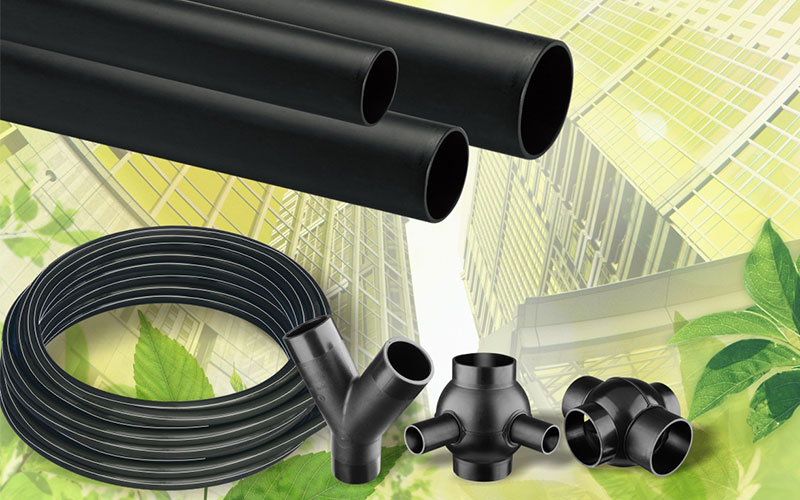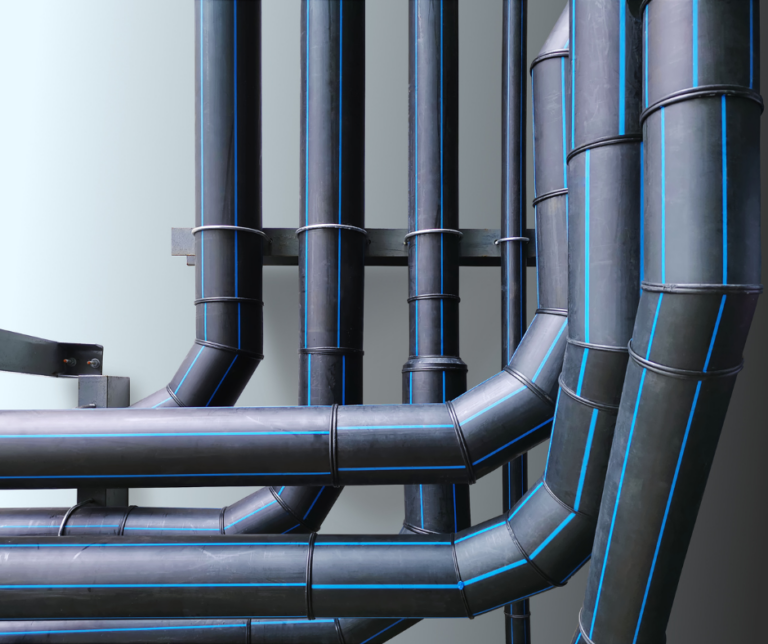Pipe Manufacturing Midland TX: Process Explained
Wiki Article
Discover the Production Refine Behind High-Quality HDPE Pipeline and Its Applications
The manufacturing process of top notch HDPE pipelines is complex and systematic. It starts with the option of basic materials that improve performance. Following this, ethylene undertakes polymerization to form resin, which is after that formed through extrusion. Quality assurance is paramount, making certain that the end product fulfills strict criteria. Nonetheless, the journey of HDPE pipes doesn't finish with manufacturing. Their applications across different sectors expose a broader value worth examining.Understanding HDPE: Characteristics and Advantages

High-density polyethylene (HDPE) is a flexible polycarbonate known for its resilience and resistance to numerous ecological factors. This product displays exceptional tensile toughness, making it suitable for requiring applications. Its low-density structure adds to a lightweight item, promoting convenience of managing and installment. HDPE also showcases remarkable resistance to chemicals, which minimizes degradation when subjected to severe materials.
The material's reduced dampness absorption even more boosts its longevity, making it excellent for usage in pipelines and storage tanks. In addition, HDPE is immune to ultraviolet (UV) radiation, guaranteeing that products keep their integrity also when exposed to sunlight. Its flexibility permits for the production of complex shapes without jeopardizing stamina. The eco-friendly nature of HDPE, often stemmed from recycled products, includes in its appeal, promoting lasting methods in production. Overall, these residential properties and benefits make HDPE a preferred selection for various industrial and consumer applications.
Raw Material Choice for HDPE Production
The selection of resources for HDPE production is vital to confirm the end product meets the preferred specifications and high quality criteria. High-density polyethylene (HDPE) is mainly generated from polymerized ethylene, derived from nonrenewable fuel sources such as gas or petroleum. The quality of these feedstocks considerably affects the mechanical and thermal buildings of the last HDPE.Ingredients likewise play a considerable duty in enhancing HDPE's performance, consisting of anti-oxidants, UV stabilizers, and colorants, which improve sturdiness and resistance to ecological aspects. The option procedure need to think about not just the chemical structure of the raw materials however also their handling qualities to ensure reliable manufacturing.
The sourcing of raw materials should focus on sustainability and compliance with ecological guidelines, as accountable practices are critical in today's market. Inevitably, cautious raw product option lays the foundation for producing premium HDPE pipelines ideal for diverse applications.
The Extrusion Refine: Shaping HDPE Pipeline
The extrusion procedure plays a crucial role in shaping HDPE pipelines, starting with thorough product preparation techniques that assure excellent circulation and consistency. Just as important is the design of the die, which directly influences the final dimensions and surface area quality of the pipeline. With each other, these factors contribute considerably to the performance and quality of HDPE pipe production.Product Preparation Methods
Reliable production of HDPE pipes begins with thorough material prep work methods, specifically the extrusion process. During this phase, high-density polyethylene material is first dried out to get rid of dampness, making sure excellent circulation features. The resin is then fed into the extruder, where it goes through heating and melting, changing right into a thick state. This home heating procedure is very carefully regulated to keep the product's honesty and performance. The liquified HDPE is required with a die, forming it into a continual pipe form. Appropriate temperature monitoring during extrusion is essential, as it straight affects the product's buildings and the last item high quality. As soon as shaped, the HDPE pipe is cooled and reduced to specified sizes, prepared for subsequent processing and applications.Die Style Importance
Accuracy in die design plays a necessary duty in the extrusion process of HDPE pipelines. The die functions as the last shaping device, directly influencing the pipe's dimensions, wall thickness, and surface area finish. A well-designed die guarantees uniform product circulation, decreasing issues such as irregularities and vulnerable points. The geometry of the die need to be enhanced to accommodate the specific residential or commercial properties of HDPE, including its thickness and thermal actions during extrusion. Furthermore, the cooling price of the material as it passes with the die can markedly affect the pipeline's structural honesty. As a result, buying sophisticated die innovation is crucial for makers intending to produce premium HDPE pipelines that satisfy sector requirements and consumer expectations.Quality Control Measures in HDPE Manufacturing
Different elements influence the high quality of HDPE pipe production, effective quality control steps are essential to guarantee consistency and dependability in the final product (hdpe pipe suppliers Midland TX). Secret top quality control techniques include strenuous product examination, verifying that the raw polyethylene fulfills established criteria for pureness and density. Throughout the extrusion process, parameters such as temperature level, stress, and cooling time are closely checked to preserve dimensional precision and structural integrityFurthermore, post-production testing is important; makers frequently carry out hydrostatic tests to assess the pipe's toughness and resistance to stress. Visual assessments for surface area defects better boost high quality assurance. Qualification from relevant standards companies, like ASTM or ISO, gives an get more info added layer of credibility. By applying these comprehensive quality assurance steps, producers can reduce flaws, boost performance, and make sure that the HDPE pipelines satisfy the details demands of numerous applications, inevitably resulting in customer fulfillment and rely on the item.
Applications of HDPE Pipeline Throughout Industries
HDPE pipelines are utilized throughout numerous industries due to their toughness and convenience. In water distribution systems, they ensure efficient shipment, while in wastewater management, they supply trustworthy options for waste transportation. Furthermore, farming watering networks gain from HDPE's resistance to rust and flexibility, making it an optimal selection for contemporary farming practices.
Water Distribution Systems
A considerable variety of sectors rely upon high-density polyethylene (HDPE) pipelines for efficient water circulation systems. Understood for their resilience and resistance to corrosion, HDPE pipes are widely utilized in community water supply networks, farming watering, and industrial applications. Their light-weight nature promotes simple handling and installment, decreasing labor expenses and time. Additionally, HDPE pipes can fit various stress degrees, making them ideal for both reduced and high-pressure systems. custom hdpe pipe manufacturing Midland TX. The adaptability of the product permits smooth combination right into existing facilities, decreasing the requirement for extensive excavation. HDPE's resistance to chemical leaching guarantees that the water provided stays safe and clean, making it a suitable choice for maintaining the top quality of drinkable water across different industries.Wastewater Monitoring Solutions
Efficient water distribution systems additionally lead the way for cutting-edge wastewater administration remedies, where high-density polyethylene (HDPE) pipes play a considerable role. Prominent for their sturdiness and resistance to corrosion, HDPE pipelines are perfect for carrying wastewater in various setups. Their flexibility enables very easy installment in complex environments, minimizing the need for extensive excavation. In addition, HDPE's smooth interior surface decreases friction, boosting circulation rates and effectiveness. These pipelines are also immune to chemical leaching, ensuring that pollutants do not jeopardize the surrounding environment. Industries, communities, and therapy centers increasingly rely on HDPE pipes for their reliability and long life, making them a preferred selection for contemporary wastewater monitoring systems. This adaptability emphasizes the critical importance of HDPE pipes across countless applications.Agricultural Watering Networks
Agricultural watering networks benefit substantially from the use of high-density polyethylene (HDPE) pipes, which supply reliable and trustworthy water distribution to crops. HDPE pipelines are light-weight, making them simple to move and set up, while their adaptability enables for various arrangements in diverse surfaces. These pipelines demonstrate exceptional resistance to deterioration, chemicals, and UV radiation, making sure sturdiness in rough agricultural settings. In addition, their smooth interior surface area reduces rubbing loss, optimizing water flow and reducing power expenses connected with pumping. The longevity of HDPE pipelines, often exceeding 50 years, adds to reduce upkeep and replacement expenditures. Consequently, farmers increasingly count on HDPE pipelines to enhance watering effectiveness and advertise lasting farming techniques, ultimately leading to improved crop yields and resource preservation.Future Trends in HDPE Pipe Technology
As the demand for sustainable and effective facilities expands, developments in HDPE pipeline technology are poised to change numerous industries. Emerging patterns consist of the integration of wise technologies, such as sensing units and IoT capabilities, which assist in real-time monitoring of pipe problems, decreasing upkeep expenses and protecting against leakages. Additionally, the development of sophisticated production strategies, such as 3D printing, is enabling the production of complicated, tailored pipeline styles that satisfy specific task demands.The focus on recycling and round economic situation methods is driving the innovation of HDPE pipes made from recycled materials, improving sustainability. Boosted jointing approaches, such as electro-fusion and mechanical installations, are additionally improving installation performance and reliability. Finally, the growing emphasis on environmental guidelines is pushing producers to embrace greener production procedures, ensuring that HDPE pipelines not only meet industry standards but additionally cultivate a more sustainable future for infrastructure advancement.
Often Asked Inquiries
How Does HDPE Contrast to Other Plastic Materials?
HDPE exceeds numerous other plastic products regarding longevity, chemical resistance, and adaptability. Its reduced density and high tensile stamina make it excellent for different applications, typically exceeding options in both efficiency and durability.What Are the Ecological Impacts of HDPE Manufacturing?
The ecological impacts of HDPE manufacturing include greenhouse gas exhausts, power consumption, and possible contamination from manufacturing processes. Furthermore, inappropriate disposal can bring about soil and water contamination, raising concerns concerning long-lasting ecological impacts.Can HDPE Pipeline Be Recycled?
Yes, HDPE pipelines can be recycled. Numerous centers approve made use of HDPE for processing, transforming it right into new items. This reusing adds to sustainability initiatives, lowering plastic waste while conserving sources and energy in the manufacturing cycle.What Is the Life Expectancy of HDPE Water Lines?

Just How Do Temperature Level Variants Impact HDPE Pipe Efficiency?
Temperature level variants significantly impact HDPE pipeline efficiency, influencing flexibility and stamina. High temperature levels can bring about softening, while low temperatures might cause brittleness, inevitably affecting the pipeline's durability and suitability for numerous applications in diverse environments.Report this wiki page